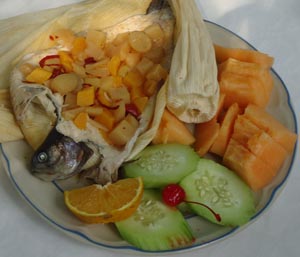Mexican Kitchen

The months of April and May, after the cool winter and before the summer rains, are the warmest times of year in Central Mexico. But as in much of the country, the mountains are never far away, and provide a refreshing break from the heat.
Some of the most thriving enterprises in the highland areas are trout farms, either run privately or as community projects undertaken by locals. Through the years, we have enjoyed fresh fish from trout farms in different regions of Mexico, where water from mountain streams feeds the ponds.
From the indigenous community of Benito Juarez, Oaxaca, with its small trout farm and adjoining humble restaurant, to the Sierra of Puebla, where several restaurants often surround larger enterprises with numerous ponds, distinctively Mexican flavors prevail.
Recently, I drove with friends to the mountain village of San Baltazar Atlimeyaya, Puebla, to enjoy fresh trout just a few hundred yards from where they are raised. The fish here are a product of aquaculture that began in Mexico in the late 19th century, when a half million rainbow trout eggs were imported from the United States to a hatchery in the State of Mexico.
Begun as a means of social support to rural communities, aquaculture in Mexico now produces several species, including shrimp, oysters and catfish, in addition to trout. The trout farms in Atlimeyaya are fed by spring water flowing down from the snow-capped Popocateptl volcano.
We visited Xouilin Granja Piscícola, one of the larger trout farms, begun in 1979, where employees at the sides of the ponds were dragging large nets that emerged with their wriggling catch. These would either be smoked and offered for sale at the farm’s onsite store, or cooked to order at one of the surrounding restaurants. The 55°F water in the ponds is snow melted off the Popocatepetl volcano.
At La Violeta, sitting under a tree next to one of the rolling streams, we enjoyed cool drinks and totopos (homemade tortilla chips) with chipotle sauce, while perusing a menu that included several different preparations of trout. Nearly all of them are wrapped in either corn husks or foil, with the seasonings enclosed in the packet, and baked just until cooked through. Plenty of freshly made tortillas and salsa are the only accompaniments needed.
It was a weekday and just after Semana Santa, so the restaurant was not crowded, although it can be fun to go on weekends and watch the kids, who come with huge family groups, run around. For anyone visiting the Puebla area, this is a great outing.
From Puebla, take the Puebla-Atlixco Highway 24 miles to Atlixco, a city known for its plant nurseries, artisanal cheeses and cecina. Either turn into Atlixco to have a coffee at one of the cafes facing its attractive zocalo, or follow the signs to the Metepec highway.
The drive through Metepec is interesting in itself, since this was a town designed by British engineers in the late 19th century as a place of residence for textile factory workers, and is now the site of a large IMSS recreational complex.
Follow the signs to Atlimeyaya and the “Truchas,” just a few minutes uphill from Metepec. And if you can’t get there, try one of these recipes at home. Use filets if you don’t want to deal with whole fish, although the heads, which should be left intact, contain the cheek meat, the most succulent part of the fish.
- Mexican Trout with garlic sauce: Trucha al mojo de ajo
- Mexican trout with epazote: Trucha al epazote
- Trout with Mexican tropical fruit salsa: Trucha con salsa de frutas tropicales
- Mexican trout with sesame seeds in parchment paper: Trucha empapelada con ajonjoli
- Mexican trout in papillote: Trucha empapelada
- Trout in Mexican macadamia sauce: Trucha en macadamia
